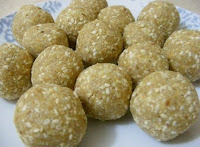As the winter in India comes towards its dying stages, the harvest festival is celebrated in different parts of India. At the end of the harvesting season when everyone's storehouses are filled with grains and the people have a broad smile in their faces seeing their granaries, they celebrate by preparing different kinds of dishes and delicious food items with the newly harvested grains.
The harvest festivals are celebrated essentially as a thanksgiving to nature for a good harvest which is a main source of livelihood in this part of the world. The dishes are first offered to the nature gods and then everyone join in a sumptuous feast. People also organise music and dance shows and enjoy for a few days to mark the festival.
Makar Sankranti is one of the most auspicious day for the Hindus, and is celebrated in almost all parts of the country in myriad cultural forms, with great devotion, fervor & gaiety. The festival is known in different parts of India in different names.
In northern India especially Punjab it is known as lohri. In eastern india, especially in Bengal, Bihar and Uttar Pradesh it is known as makar sankranti. In Assam in the north-east it is known as bhogali bihu, in the south especially in Tamilnadu it is known as Pongal. In Karnataka it is known as puthari, in Andhra Pradesh, it is known as bhogi or sankranti, in Kerala as kakkoor kalavayal.
Makar Sankranti marks the commencement of the sun's journey to the Northern Hemisphere and is a day of celebration all over the country. The day begins with people taking holy dips in the waters and worshipping the sun. The makar sankranti is the last day of the pous, a month in the hindu calendar.
In this day , in the northern India people take a dip in the river Ganges in places like Prayag in Uttar Pradesh, Hardwar in Uttaranchal, Patna in Bihar, Ganga Sagar in West Bengal and many other places. The sun transcends to its northward journey orUttarayan and the day is generally one of the coldest in the entire winter.
In this day , in the northern India people take a dip in the river Ganges in places like Prayag in Uttar Pradesh, Hardwar in Uttaranchal, Patna in Bihar, Ganga Sagar in West Bengal and many other places. The sun transcends to its northward journey orUttarayan and the day is generally one of the coldest in the entire winter.
Different kinds of food items are prepared in almost every household, which they savour themselves and also distribute among friends and relatives. In Bengal and Assam it is known as Pitha or the rice cake, although it is prepared in a different manner among the bengalis and the assamese. The bengali items are mainly soft in nature and has to be savoured instantly, whereas the assamese ones are dry and stored for a long time. Coconut is the main item to prepare the pitha.
In Assam people prepare a hut kind of structure with hays known as mejhis, which is later burnt and the delicacies prepared are offered to the fire god. The women members prepare the delicacies during the night and the male members and small girls lit bonfires and sing and dance around them.
In Bihar the biharis prepare dahi-chura by mixing curd and a kind of fried rice. In Punjab and Maharashtra households prepare tilache laddus or sweets made of sesame seeds or til and jaggery or gud.
Punjabis also prepare laddus and other sweet delicacies with peanuts and jaggery. Huge bonfires are lit on the eve of sankrant and which is celebrated as lohri. Sweets, sugarcane and rice are thrown in the bonfires, around which friends and relatives gather together. The following day, which is sankrant is celebrated as maghi. The Punjabi's dance their famous bhangra dance till they get exhausted. Then they sit down and eat the samptions food that is specially prepared for the occasion.
In Gujarat people generally distribute food items to relatives, they also fly kites to mark the occasion as also the people of Rajasthan. In Madhya Pradesh this festival of sankrant is known by the name sakarat and is celebrated with great pomp merriment accompanied by lot of sweets.
In Karnataka a preparation of rice is offered to cows and bullocks, which are beautifully decorated and is considered sacred here. There are also song and dance arrangements to celebrate puthari here. Men, women and children attired in colourful tunics visit friends and relatives and exchange pieces of sugarcane, a mixture of fried til, molasses, pieces of dry coconut, peanuts and fried gram. The significance of this exchange is that sweetness should prevail in all the dealings.
Pongal in tamil means ‘to boil’. It is essentially a four day festival where different rituals are performed on each of these days. On the first day different unutilised items are thrown into the fire, lit of wood. The fire also keeps everyone warm in the cold winter. Girls make merry by dancing around the fire.
The festivities all round embody a spirit of brotherhood, unity and gratitude, with family reunions and merrymaking generating a lot of happiness, goodwill and cheer.
. . .















No comments:
Post a Comment